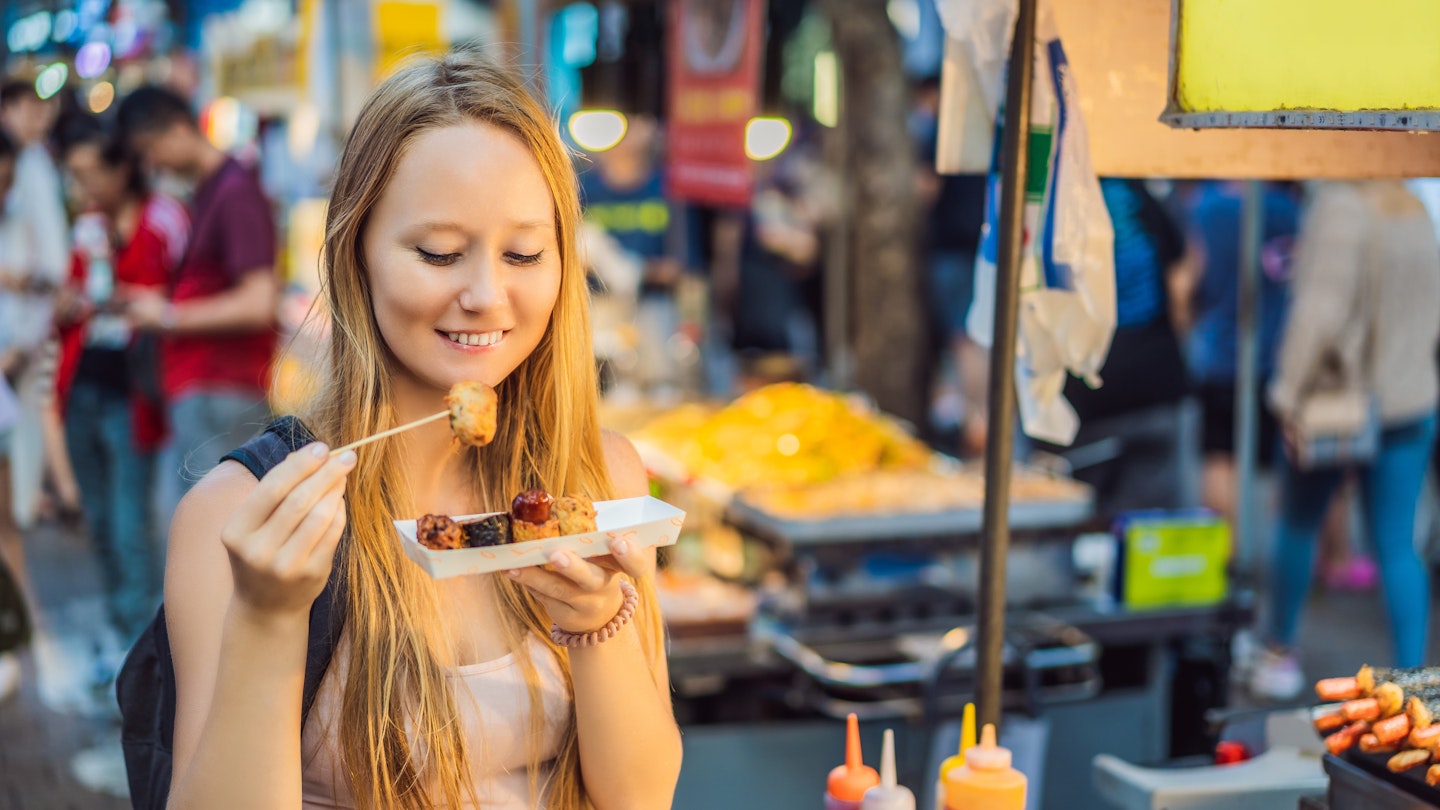Discover Korean Cuisine: A Food Lover’s Guide
In Korea, food is for the soul as well as for the stomach. Meals are meant for sharing, and eating is seen as a means to better health and well-being. Known for spicy flavors, Korean food culture is all about the sauces and condiments and, in turn, fermentation – exemplified by the national treasure that is kimchi and fiery gochujang (red chili paste).
Koreans love eating out, and dining options range from casual bites at a market stall to regal banquets at traditional restaurants. In the big cities, food trends come and go at a breathless pace, making contemporary dining in Korea – especially street food – ideal photo fodder for online foodies.
Get Your Grill On at a Korean BBQ
Hands-down the best hands-on eating experience in Korea, there’s something special about sizzling meat with friends on a tabletop grill that encourages great conversation.
The first step at a Korean BBQ restaurant is to select your cuts: beef, typically galbi (short ribs) or bulgogi (thinly-sliced sirloin marinated in sweet soy sauce), and pork, such as samgyeopsal (streaky pork belly). After grilling, wrap each meaty morsel in ssam (vegetable leaves) before eating, along with optional fresh garlic, green pepper, kimchi, and spicy ssamjang (soybean and red-pepper sauce). And don’t forget the beer.
Savor an Elegant Korean Banquet
For a more refined dining experience, hanjeongsik is a royal spread of banquet dishes all served at once: fish, meat, soup, dubu jjigae (tofu stew), rice, noodles, steamed egg, shellfish, and a variety of banchan (cold side dishes). It offers a delightful way to sample a wide range of seasonal Korean food in one go.
The best places serve dishes in regal bangjja (bronze) tableware, set out aesthetically on the table according to color and taste profile, creating an edible work of art.
Chow Down on the Perfect Bibimbap
Comfort in a bowl, bibimbap is the definitive Korean staple: rice topped with vegetables, sometimes meat, chili paste, and egg. The ingredients are arranged according to the five primary colors of Korean food—white, yellow, green, red, and black—representing elemental balance. Add a squirt of red gochujang, stir, and enjoy. Bibimbap originates from the food-centric city of Jeonju, along with dolsot bibimbap, served in a hot stone pot to create a deliciously crunchy layer of rice at the bottom.
Appreciate the Culinary Joy That is Kimchi
In Korea, kimchi is present at every meal—what started as a pickling method for vegetables during winter has become a culinary cornerstone. Kimchi is said to lower cholesterol, enhance gut health, and boost immunity. One of the best ways to enjoy kimchi is through kimchi-jjigae, a bubbling stew made with kimchi, tofu, and vegetables. It’s a comforting choice that can be enjoyed any time of day.
Go for a Fried Chicken and Beer Blowout
A pairing so perfect it even has a name—chimaek refers to fried chicken (chikin) with beer (maekju), enjoyed at restaurants and pubs across Korea. The beer is typically frothy drafts of lager and the fried chicken comes either plain or generously glazed in a gochujang-based sweet and spicy sauce. To truly experience the variety, guests often order banban to get a mixed plate of both styles. The best Korean fried chicken is light and crispy, thanks to the double-frying process.
Dine Out on Korean Street Food
Korean street food vendors range from simple carts to pojangmacha (street tent bars) with seating. You’ll find iconic dishes like tteokbokki—chewy rice cakes cooked in spicy gochujang—and odeng (fishcake skewers) served in flavorful broth. Dakkochi are grilled chicken skewers, known for their smoky taste, while sweet treats include bungeoppang (fish-shaped red-bean waffles) and hotteok (sweet pancakes filled with brown sugar syrup).
Slurp a Bowl of Ginseng Chicken Soup
It might seem counterintuitive, but eating hot soup on a warm day is a popular practice in Korea. Samgyetang is a flavorful chicken soup featuring a whole bird stuffed with ginseng and other healthful herbs, traditionally enjoyed during the hottest days of the year to replenish energy and internal warmth.
Drink Makgeolli and Eat Pajeon
A traditional farmer’s brew, makgeolli is a fermented rice wine, often enjoyed for its mellow yogurt flavor. It’s typically paired with pajeon, a savory pancake made with green onions and sometimes seafood or kimchi. This comforting combination is a favorite, especially on rainy days.
Vegetarian and Vegan Options
While Korean cuisine includes a variety of vegetables, many dishes come with meat, making vegetarian dining a challenge. Vegetarian options such as bibimbap without meat or egg exist, but traditional dishes like dubu jjigae may use beef or seafood stock. Therefore, it’s advisable for vegetarians to seek out dedicated vegetarian restaurants or Buddhist temple eateries for guaranteed meat-free meals.





